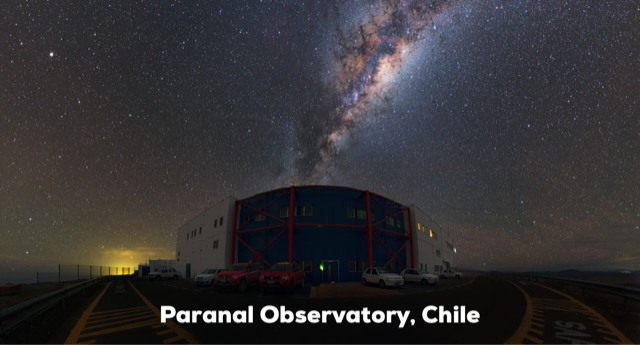
From night to night, the stars march inexorably across the sky just like they’ve done for millennia. Looking up at a star-filled sky, it’s easy to lull yourself into believing that the stars are all the same in appearance, unchanging and eternal. But if astronomy teaches us anything, it’s that nothing within this universe lasts forever, the only true constant is change and that applies to stars as it does to galaxies, planets, petunias, and people. You might have seen recent news headlines that Betelgeuse, one of the most familiar stars in our winter sky, has undergone some rapid and dramatic changes in brightness. What does it mean? Is it a sign that Betelgeuse is about to explode in a supernova?
HOW TO PRONOUNCE “BETELGEUSE”

There actually isn’t a single common way to pronounce the star’s name. “Betelgeuse” is often said to derive from the Arabic “Yad al-Jawza”, meaning, “the hand of Jawza” (Jawza, being the Arabic name for Orion). During Medieval times, the “Y” in “Yad” got mistranslated as a “B” and, long story short, we’ve now got “Betelgeuse”. I don’t speak Arabic but, according to the literature, “Betelgeuse” translates as “the armpit of Jawza”. Awkward.
So, you can pronounce it with the ‘e’ long or short, and the ‘s’ as either ‘s’ or ‘z’. But the main thing to remember is, if you say the name three times in quick succession, a mischievous poltergeist is unlikely to appear.
HOW TO FIND BETELGEUSE
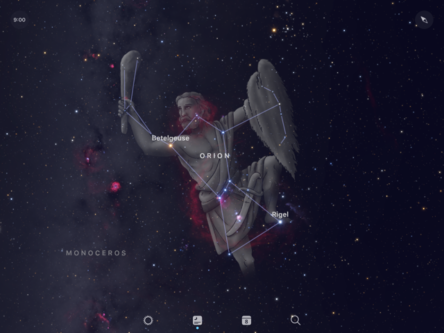
Betelgeuse is the second brightest star in the constellation of Orion and it denotes his right shoulder (left from our perspective). During the first half of the month you can find the great hunter by stepping outside at around 9:00 PM CST and facing the southeast. At this same time during the latter parts of the month, Orion will be located directly south. As the evening hours progress, and as the nights go by, Orion stalks ever more towards the west. He finally disappears from our evening sky around April.
The best way to spot Betelgeuse is by looking for the grouping of three stars in a row and informally known as “Orion’s Belt”. South of the Belt you will find the brightest star in Orion, the blue-white colored Rigel. Orange-red Betelgeuse is the second brightest star in the constellation (usually) and can be found north of the belt. Use the accompanying image to help guide you, or use an astronomy app if you have one on your smartphone or other device.
WHAT YOU ARE SEEING
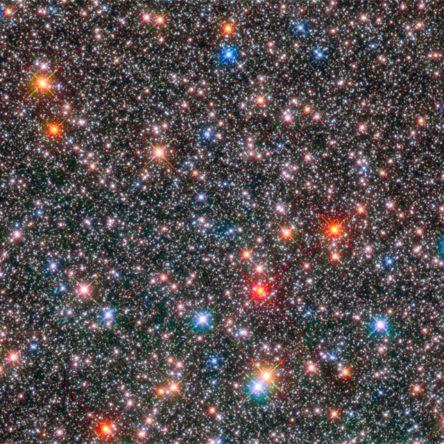
One of the more common misconceptions about stars is that they are all just white pinpoints of light in the sky. But look closer and you’ll see that they come in other colors too, ranging from red to orange to yellow to blue. Sometimes these colors are best observed with a little optical aid. Try using a pair of binoculars with Betelgeuse. What do you see? You should easily detect a distinct orange-red hue. Take a look at Rigel with the binoculars and notice its blue-white hue. Compare and contrast the colors between the two stars.
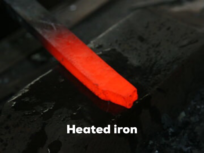 Star colors are directly related to their surface temperatures. To better appreciate this relationship, imagine slowly heating a piece of iron. As it begins to get hot, the iron starts to glow red. As it gets even hotter, the iron begins to glow orange, then yellow. Increase the temperature even more and it will finally begin to glow with a white radiance before finally transitioning to blue. So, contrary to what your water taps might tell you, things that glow red are cooler than things that glow white or blue. Red stars like Betelgeuse therefore have much cooler surface temperatures than do blue-white stars like Rigel. Betelgeuse has a surface temperature of 3,500 Kelvin. Kelvin is the temperature scale used by astrophysicists, where zero is the absolute coldest anything can conceivably get. If we apply the Kelvin scale to something we can easily relate to, like the freezing and boiling points of water, we find that we get temperatures of 273.15K and 373.15K respectively. So, 3,500K is pretty toasty by our everyday standards, but for a star, it’s relatively cool. For comparison, the Sun’s surface temperature is about 5,778K while Rigel’s is 11,000K.
Star colors are directly related to their surface temperatures. To better appreciate this relationship, imagine slowly heating a piece of iron. As it begins to get hot, the iron starts to glow red. As it gets even hotter, the iron begins to glow orange, then yellow. Increase the temperature even more and it will finally begin to glow with a white radiance before finally transitioning to blue. So, contrary to what your water taps might tell you, things that glow red are cooler than things that glow white or blue. Red stars like Betelgeuse therefore have much cooler surface temperatures than do blue-white stars like Rigel. Betelgeuse has a surface temperature of 3,500 Kelvin. Kelvin is the temperature scale used by astrophysicists, where zero is the absolute coldest anything can conceivably get. If we apply the Kelvin scale to something we can easily relate to, like the freezing and boiling points of water, we find that we get temperatures of 273.15K and 373.15K respectively. So, 3,500K is pretty toasty by our everyday standards, but for a star, it’s relatively cool. For comparison, the Sun’s surface temperature is about 5,778K while Rigel’s is 11,000K.
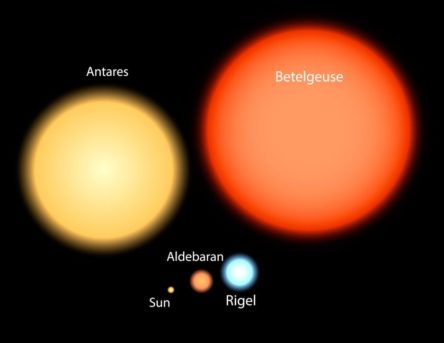
Betelgeuse is an example of a red supergiant star. By volume, these are some of the largest kinds of stars that we know of. Such stars begin their existence being much more massive than the Sun but have depleted the store of hydrogen fuel within their cores and are now entering the final stages of their lives. As they go through these final stages, their outer layers swell to monstrous, though tenuous, proportions. Betelgeuse contains about 20 solar masses and has a radius of over 600 million kilometers, if you were to replace the Sun with Betelgeuse, its outer layers would engulf all of the inner planets, the asteroid belt, and possibly even Jupiter.
Massive stars like Betelgeuse burn through the fuel supplies within their cores much more quickly than do less massive stars like the Sun. The Sun has been around for some 4.6 billion years and still has another 5 billion years left. By comparison, Betelgeuse is only some 10 million years old and it is already nearing the end of its life. Stars like the Sun, left to their own devices, usually end their lives with a whimper. They run out of fuel, their cores contract and heat up, they puff off their outer layers, expose their white-hot cores and slowly cool down over the course of billions of years. Stars like Betelgeuse however have a different fate. At the end of their lives, deprived of any fuel within their cores, they can no longer radiate the energy needed to stave off the inexorable force of gravity that has always tried to crush them down. Once they reach that point, they have less than a second to live. The star suddenly collapses in upon itself and the result is a titanic explosion that we call a supernova.
SO WHY HAS BETELGEUSE DIMMED IN BRIGHTNESS?
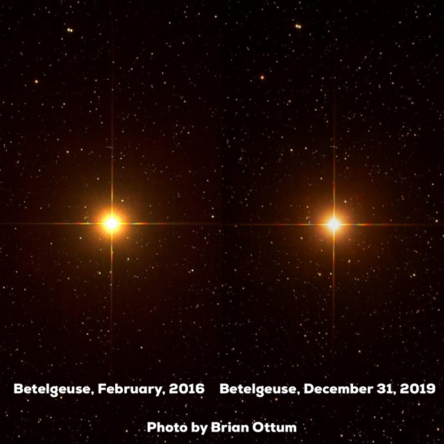
On average, Betelgeuse is among the top 10 brightest stars in our night sky (usually coming in at 9th or 10th place). But back in October of 2019, astronomers began to notice that is was fading in brightness. By December, it was no longer in the top 10 list. It wasn’t even in the top 20. The news media immediately picked up on this dramatic change taking place with Betelgeuse and many headlines were proclaiming that a supernova was imminent. So, is the star about to go “boom!”? Well, probably not. Here’s why.
Betelgeuse is a variable star. These are stars whose brightness changes with time. They are quite common. We know of at least 150,000 such stars and there are many thousands more that we suspect are variable. In fact, we amateur astronomers often monitor these stars in order to help professional astronomers keep a continuous data base of their antics. The American Association of Variable Star Observers (AAVSO) is an organization to which many amateur and professional astronomers belong and whose task it is to observe, record, and analyze these fascinating stellar objects. Broadly speaking, variable stars fall into one of two categories: “extrinsic variables”, stars whose brightness changes due to the geometrical alignment of a companion that orbits around the star, causing it to dim and brighten with clockwork regularity and “intrinsic variables”, stars whose brightness changes due to processes going on deep within the star or its outer atmosphere. Betelgeuse is an intrinsic variable and this category has several sub-categories. In this case, we are talking about a “pulsating variable”, a star whose outer layers expand and contract with some degree of regularity. When a pulsating variable expands its outer layers, it becomes brighter because it has an increased surface area from which to emit light; when it contracts, it grows dimmer because that surface area is now greatly diminished. These pulsations are due to the star alternately trapping and releasing the intense heat being generated from within the core.
These periods of expansion and contraction occur approximately every 425 days or so. On top of this cycle, there are a couple more that take place in the star’s atmosphere. One of these cycles operates on a time scale of several months while the other has a period of almost 6 years. So, it could be that the dramatic dimming that we are seeing is due to the overlapping of some of these cycles. On shorter time frames, the dimming and brightening of Betelgeuse can sometimes be attributed to gargantuan starspots (similar to our own star’s sunspots) and the convection of hot, bright blobs of gas rising up through the star’s atmosphere. But, in all honesty, we just don’t know for certain what’s taking place with Betelgeuse. Thanks to records kept by the AAVSO, we can look back over the past 100 years and see that there have been a number of times when Betelgeuse has dimmed this much before. However, we have never seen it dim this much, this quickly.
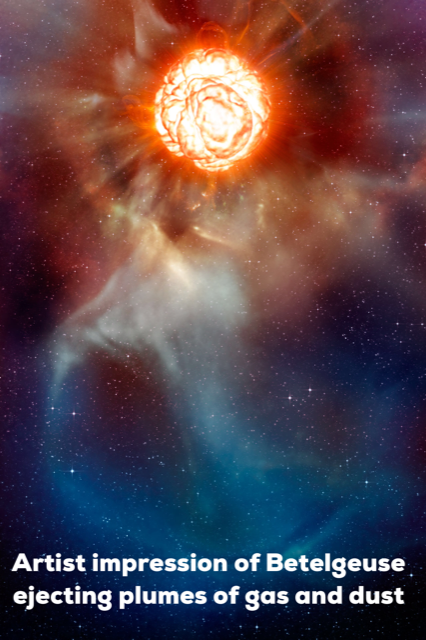
But what you really want to know is: when will Betelgeuse go supernova?
Unfortunately, we just don’t know the answer to that question either. We would need to have some pretty detailed information as to what processes are taking place within the star’s core and we just don’t have any way of knowing that for sure. Most astronomers believe that, having fused all of the hydrogen in its core to helium, that Betelgeuse has now switched over to helium burning, a process that will take approximately 100,000 years to complete. As it converts it helium into carbon, Betelgeuse’s core will contract even more, become even hotter and then start fusing the carbon to oxygen. It will keep on making heavier and heavier elements until it finally reaches iron, whereupon the core stops fusing altogether and the star collapses in upon itself, triggering the end with a supernova. So, by our best estimates, Betelgeuse still has a long way to go before we get to see a supernova. But, without knowing for sure what’s going on inside the core, we cannot say that it’s definitely, 100% not going to explode anytime soon either.
So, what will happen when Betelgeuse does explode? Well, don’t fret, we won’t be in any danger. Betelgeuse is estimated to be over 600 light years away, it would have to be at least half that distance before it poses any kind of threat to the Earth. But there will be a spectacular light show in the night sky whenever it does go supernova. The star will become so bright, that it could potentially become brighter than the full moon, being visible even during the day for many months. Try and imagine how bright it would be if you had both a full moon and a supernova of this magnitude together in the night sky. It would certainly be casting some shadows! Betelgeuse might well be around for another 100,000 years but that doesn’t stop me from going out and looking up, all the while saying silently to myself, “oh please, oh please, oh please!”.